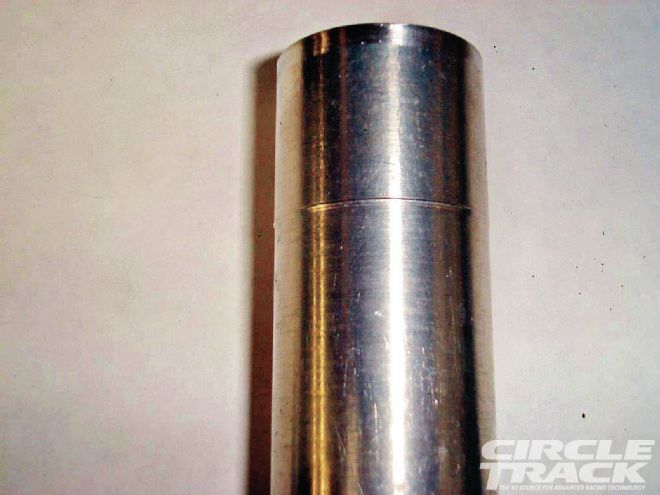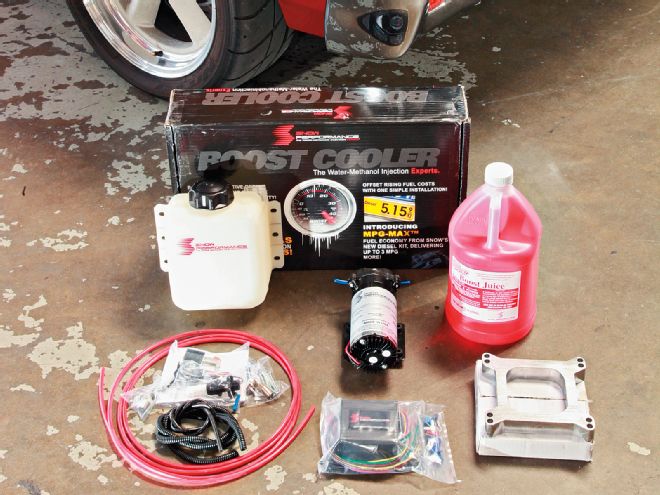
It's a rare thing when a magazine tests the exact same product twice, but that's exactly what we're doing here. Back in our Aug. '11 issue ["Hooked On Meth"], we installed and dyno tested a Snow Performance Stage II Naturally Aspirated Muscle Car water/methanol injection system (PN 20020) on a 392ci 12:1-compression Ford Windsor stroker, and picked up 50 hp peak to peak when run on 93-octane pump gas. For that test, our guinea pig baselined with VP113 race fuel, then with 93-octane pump gas and the Snow injection with a 49/51 mix of methanol and water. With no loss in power during the first comparison, the next test was conducted without the water meth injection, the same 36 degrees total timing, and the chassis dyno test showed a 50hp loss peak to peak, and as much as 88hp loss at 6,100 rpm.
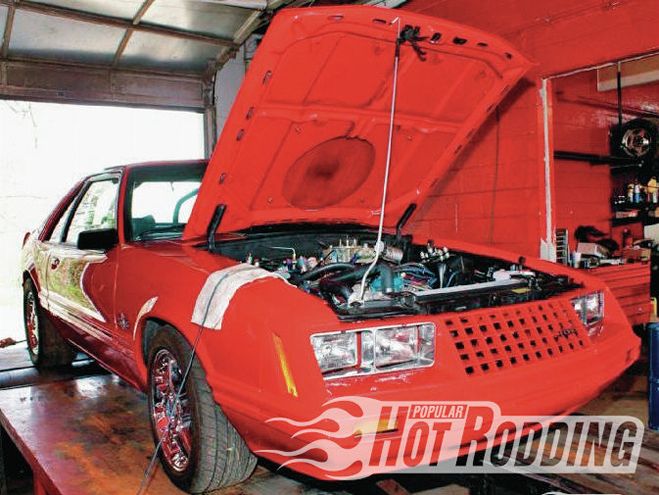 Back in the Aug. ’11 issue, we tested the same Snow Performance Stage II Muscle Car kit on a ’79 Mustang with a 392ci small-block Ford with 12:1 compression. Normally run on VP113 race gas, the ’Stang lost up to 88 hp when 93-octane pump gas was substituted. The water/meth injection restored all the lost power, while allowing the engine to run on 93 octane.
Back in the Aug. ’11 issue, we tested the same Snow Performance Stage II Muscle Car kit on a ’79 Mustang with a 392ci small-block Ford with 12:1 compression. Normally run on VP113 race gas, the ’Stang lost up to 88 hp when 93-octane pump gas was substituted. The water/meth injection restored all the lost power, while allowing the engine to run on 93 octane.
That test was conducted on a car that really needed it—the water/meth injection was actually making up the octane deficit to allow the same performance with water/meth injection and pump gas that it had with race gas alone. The test conditions were also adverse to an engine with little octane tolerance, as the ambient temperature was 90 degrees.
There's a huge benefit to the Snow system for guys with high-compression race engines who want to run them on the street with just pump gas—the long-term cost savings in race fuel is worth the price of admission alone (The Snow Stage II kit runs $546.66 through Summit.), but what would a guy with a pump-gas optimized engine stand to gain? We wanted to know, so we ordered another kit to test on Project Nova, our '68 Chevy II, which has a very healthy 10.6:1-compression 400ci Dart SHP 400 with Pro-1 heads, Dart dual-plane intake, COMP Cams Big Mutha Thumpr hydraulic roller cam (243/257 degrees duration at .050, .533/.519 inch lift, 107 degrees LSA), Performance Distributors DUI distributor, and a Holley 750 Ultra Double Pumper.
We've been pounding this Dart small-block on the street and highway now for a couple of months, and even with a full 37 degrees of total ignition timing (not to mention 28 degrees of base timing) and junky 91-octane fuel, we've not heard the slightest ping of detonation. On paper, it looked like there was nothing to gain from meth/water injection. With state-of-the-art combustion chambers in our aluminum Dart Pro-1 heads and a lopey cam to swallow the 10.6:1 compression, it looked like the deck was stacked against the Snow meth/water injection. Or was it? We decided to find out, so we loaded up the Nova and headed to our favorite shop, Outlaw Motorsports in Riverside, California, for the install and dyno test.
In this round of tests, we used a Mustang chassis dyno, which is famously stingy compared to others. To wit: Our earlier chassis dyno tuning session with the Nova on Westech's SuperFlow chassis dyno netted 385 peak rear-wheel horsepower. Notwithstanding, our baseline peak power on the Mustang dyno checked in at 323.9 hp and 5,900 rpm. With the Snow methanol/water injection, peak power rose modestly to 329.9 hp (also at 5,900 rpm). The gain of 6 rear-wheel horsepower showed that there was indeed more oats in the Dart SHP 400's feedbag. Our methodology was to baseline our previously optimized tune on 91 octane, then to obtain the same 12.5:1 air/fuel ratio with the Snow meth/water kit activated. To achieve the same air/fuel ratio and maintain a level playing field, the crew at Outlaw Motorsports (Riverside, California) removed three jet sizes from the secondaries to bring the air/fuel ratio into the baseline's 12.5:1 range. No changes in ignition timing were made throughout.
If this was the end of the story, we'd be happy to report the 6hp improvement, but there's more. During the drive home, we noticed a significant improvement to throttle response and midrange power with the Snow water/meth injection. We quickly dug out the dyno sheets from the camera bag to discover that there was an extra 30-plus lb-ft of torque on tap from about 3,500 to 4,000 rpm. The Snow kit was behaving more like a small hit of nitrous as it approached our engine's torque peak. There's no telling the gain we'll feel as summer temperatures soar and the charge-cooling effect becomes even more apparent.
We're still not quite clear what to attribute the improvement in power and response to; it could be the improved charge cooling and better octane tolerance, or it could be the enrichment curve provided by the Snow injection controller, which provides a computer-controlled pulsed delivery curve that a mechanical carburetor just can't match. Likely, it's a combination of both. All we know is that we like it! Follow along as Ron Aschtgen and Outlaw Motorsports perform our installation.
Job one is finding the right real estate under your hood to mount the pump, tank, and controller. The Snow pump must be below the tank because it’s gravity fed—we found the perfect place on the driver side near the radiator bulkhead. We had to relocate the horns to make it all work.
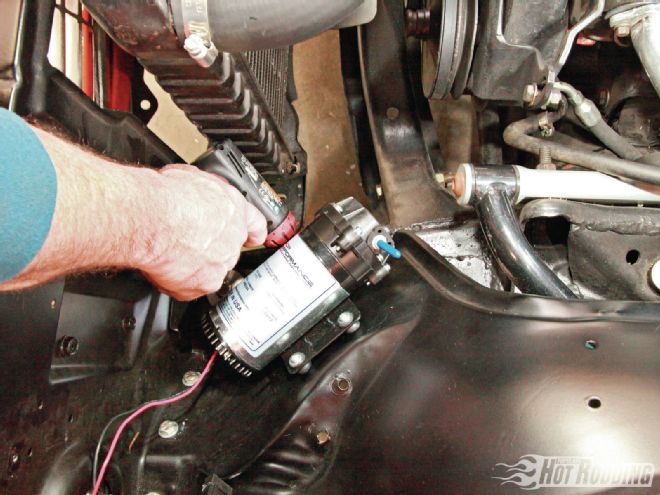
The meth/water reservoir comes with an optional fluid level sending unit. This sends a low warning signal to a cockpit indicator light. Snow lets you place it anywhere on the tank—which will vary depending on your tank’s placement and harness routing.
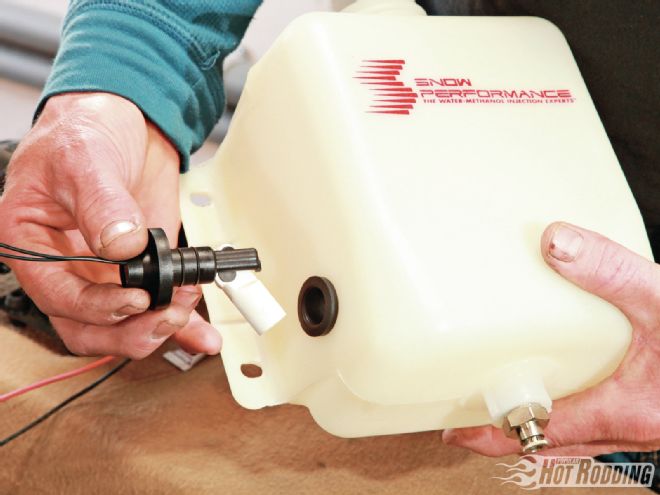
Ron Aschtgen of Outlaw Motorsports found the perfect place to mount the methanol/water tank on the radiator bulkhead. Except for the Snow label, it even looks like an OEM piece. Not shown is the anti-siphon solenoid that is placed between the tank and the pump. This prevents fluid from being sucked into the induction when the system is not operating.
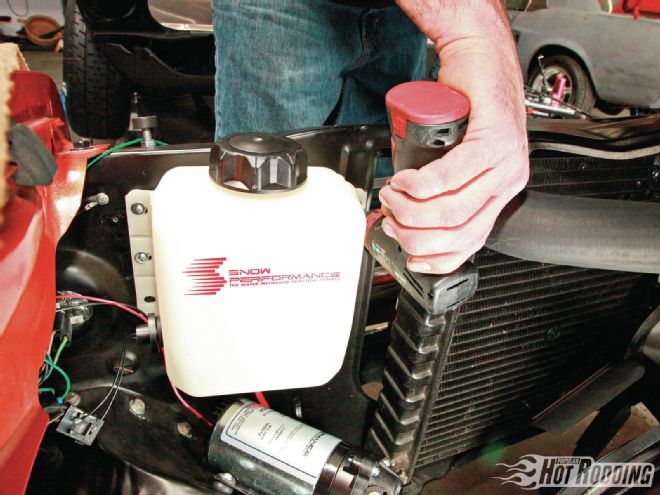
We mounted the Snow controller near the tank on the driver-side fender. The controller has a vacuum port provision that draws from the carburetor, and two set screws that allow adjustment of the injection start vacuum (injection onset) and the max injection vacuum. The minimum rpm window is set by grounding out the purple wire for 5 seconds while the engine is running at the desired rpm. When active, the controller ramps in the water/meth mixture by pulsing the power signal to the pump.
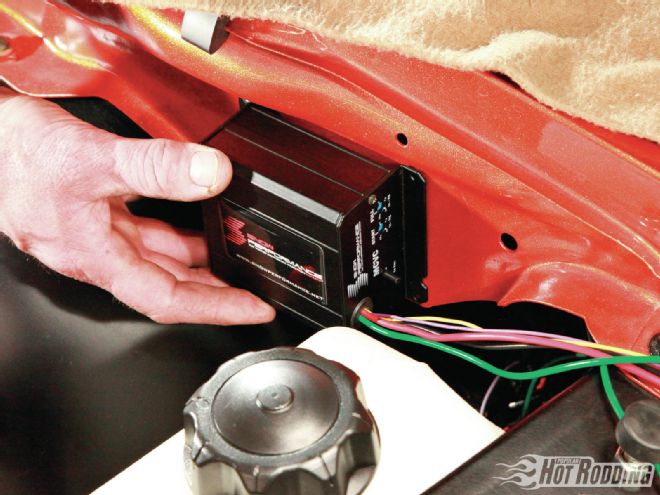
The Snow Muscle Car Stage II kit includes this 1-inch carb spacer with an injection port and a vacuum port. You’ll need to select one of three injector nozzles to install in the injector adapter—a chart in the instructions will help you match your nozzle to the engine’s power level.
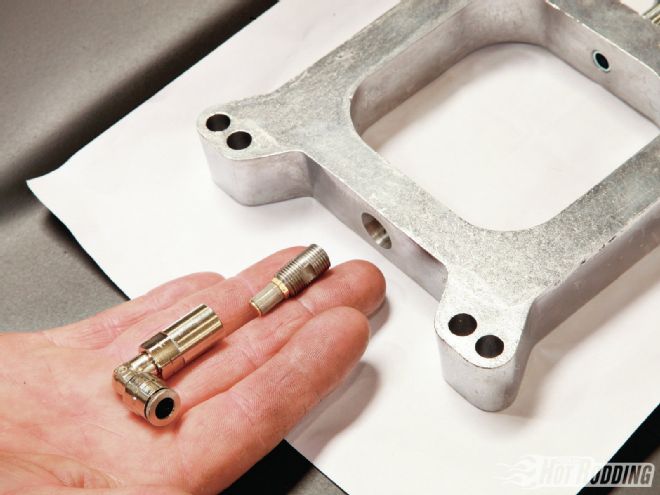
The plumbing is a simple push-lock deal—just cut the included line to length, route it out of harm’s way, and push the tubing into the fittings until they click. One line goes from the nozzle to the pump, another from the pump to the anti-siphon valve, and another from the valve to the reservoir tank.
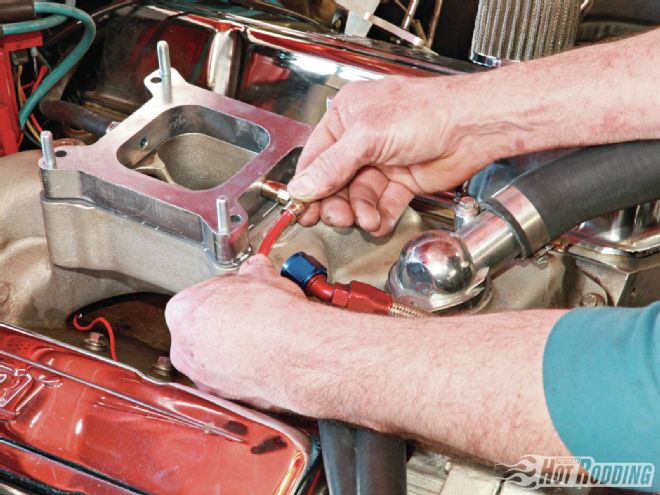
Wiring will take longer than anything else, but is still a breeze. There are connections for 12V power, ground, anti-siphon solenoid, active indicator light, low-fluid indicator light, rpm sensor wire, and the tank sending unit. Outlaw’s Aschtgen did a swell job of hiding all the wires out of sight.
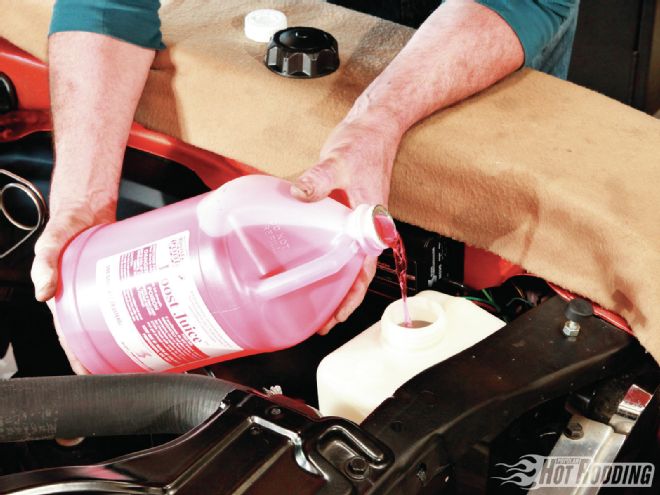
The installed Snow Performance Stage II Muscle Car kit (with the horns reinstalled near their prior position). Working at a leisurely pace, it took about five hours to get the job done, including the wiring.
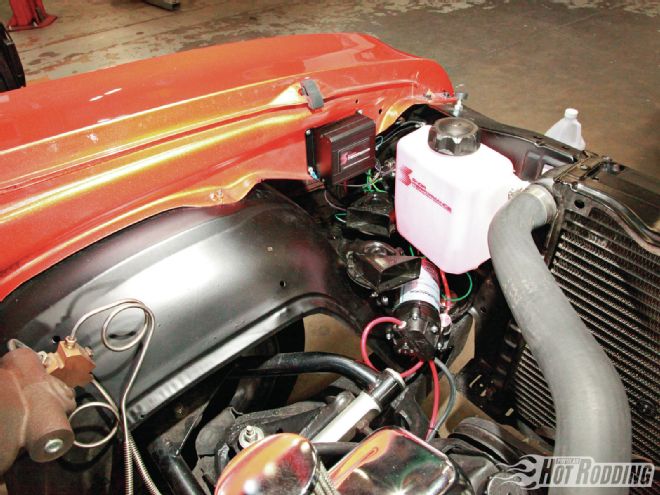
We filled up the tank with Snow Boost Juice, a 49/51 ratio of methanol and water. Many users also report good results with windshield washer fluid, a 30/70 ratio of methanol and water. (Snow says that works well too.) A four-gallon box of Boost Juice runs about $33 from Summit, enough to fill the three-quart reservoir more than five times. Driven aggressively on the street, one reservoir filling should last several tanks of gas.

With the Snow kit installed, all we needed to do was set the rpm limit with the purple wire, and adjust the vacuum activation set screws on the controller. From Snow, the controller is set to turn on all the time when powered, so you’ll know it’s working right away. Big cams like ours produce a low vacuum even at idle, so we had to tweak the controller some to keep it turned off under part throttle.
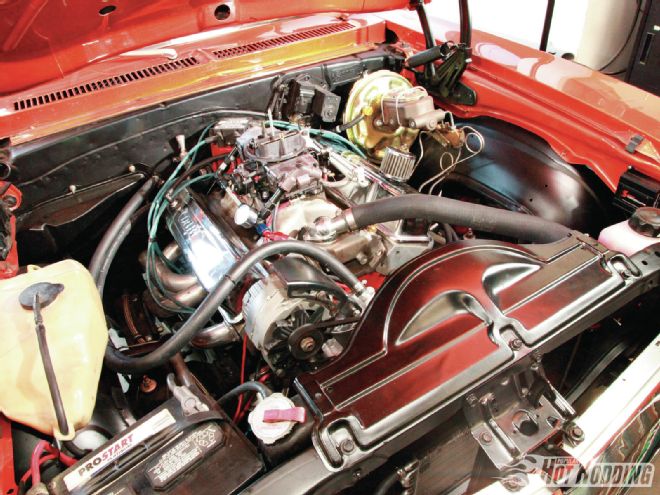
The Mustang chassis dyno doesn’t give up ponies easily, but it showed an extra 6 hp with the Snow system turned on. The big difference, however, wasn’t noticed until we hit the highway. We observed an extra 30 lb-ft of torque between 3,500 and 4,000 rpm—a difference you’re far more likely to feel than an increase in peak power. Here’s a teaser: Snow makes a Nitro Booster additive (8 ounces, PN 40007, $33.95) with a proprietary mixture of nitromethane. Snow reports it’s typically worth 30 to 50 hp. Sounds like something we’ll have to try!
